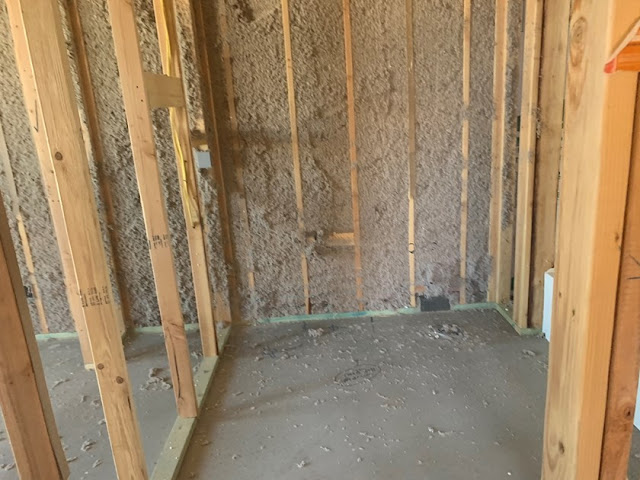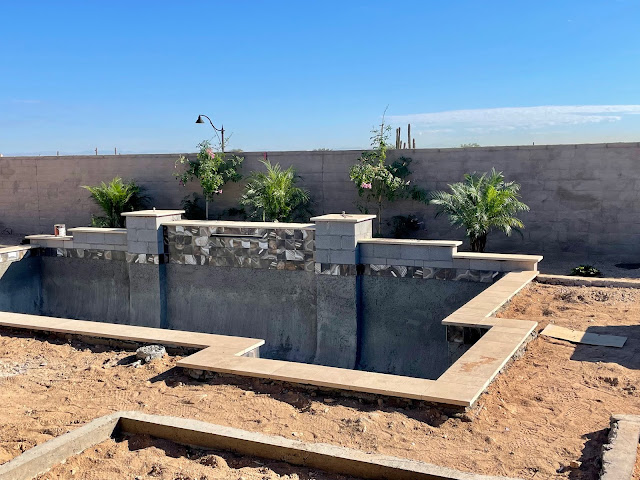WEEK 23: Still Waiting + E-Bikes
Not a lot has been done this last week at the house. It seems like the crews work in 'waves', so when our wave hits a lot gets done. Otherwise, not so much.
Insulation - This week we are anticipating that all of the interior insulation foam will get covered as they prepare for hanging the drywall. I noticed also that someone had gone in and vacuumed all of the cement, so nothing is on the floor now. I do like how they manage the constant cleanup of the construction floor.
Master Bathroom - They did manage to sneak in and build the frame for the ceiling bump-down where the mirrors will sit (below). This has no real functional use, purely design.
Finished product - Here is the architect's view of what the finished exterior of the house will look like. Of course, our landscape plan is totally different, so the appearance changes dramatically, hopefully for the better!
MORE STUFF!
E-Bikes: Some of you have requested info on the e-bikes that Jan and I recently purchased. E-bikes are a battery/electric, pedal-assisted version of a regular bicycle. Essentially, when you pedal in any of the various assist modes, the battery provides additional help in rotating the pedal gear, enabling you to ride hills in a more fluid motion and with much less effort.
I initially asked the question - "What is the benefit of e-bikes if they don't improve aerobic performance (the enabling and improvement of the body's efficiency in absorbing and transporting oxygen)." As an example, running is an aerobic exercise, while weightlifting is an anaerobic exercise.
The answer is - While normal pedal-pushing bike riding is significantly more aerobic, the data shows that people who purchase e-bikes tend to ride them much longer, and more frequently, especially in older age groups. As a result, the significant increase in frequency of rides, and the attendant motion for longer periods, outweighs the aerobic/anaerobic argument. Simply put, you ride more often, and for longer periods with an e-bike than a regular pedal-push.
Types of e-bikes: While we did a fair amount of research, we didn't do anything exhaustive, and there are a ton of e-bikes available if you can get them. In our research, we found that you can buy e-bikes from approximately $800 to upwards of $10,000. There are a myriad of manufacturers popping up from Chinese versions to those made in the USA. We elected to buy one of each, an e-bike (mine) made in China for an American name brand, and a version made in the US for another. Why? Jan's USA e-bike is more expensive, we bought it first, and I just didn't want to spend the same amount while we are currently buying a boatload of new furniture/stuff for the new house.
Jan's version (above) is a Trek Townie Go! 5D Step-Thru, and it ran about $2,800 after accessories and taxes (Arizona). It has a Bosch PowerPack 400 (250 watt motor/36V battery), 4-levels pedal assist, Shimano 5-speed derailleur, Internal hub gears, disc brakes, and weighs about 55 lbs. This is basically an all-Bosch and Shimano setup.
Pros:
- Bosch battery system is a BIG plus. Very reliable and serviceable. Jan's battery was charged in December, and I just did a recharge yesterday, but it still showed 4 out of 6 bars of charge remaining!
- Sealed rear hub gearbox, which eliminates gear messes and dirt.
- Well-made, extremely quiet, and everything feels quality. We bought from a local Trek dealer, so service is very near to us.
- Center mounted battery is important. Rear mounted batteries tend to force a more imbalanced bike handling, where the frame mount is unnoticeable.
- Mostly a town bike, but can be used on trails as well.
Cons:
- Is a pedal-assist version only, which means there is no "throttle-assist" when you aren't pedaling.
John's version (above) is an Aventon Level Commuter e-bike, and it ran about $1,800 all-in, has a 500 watt motor/48V battery, 5-level pedal assist, throttle-assist, 8-speed derailleur, and weighs in at 62 pounds.
Pros:
- Lots of stuff for the price. Pretty much comes fully equipped without having to add a bunch of accessories.
- I like the "throttle-assist" feature, which means the e-bike will move forward without pedaling by pressing a throttle button (similar to a motorcycle throttle). Note: this can also be dangerous!
- Center-mounted battery for better bike balance.
Cons:
- Chinese made. While it looks okay, you can see where some nuts and bolts will probably not hold up as well as the Trek. Mine is also a bit noisy when riding (hub noise), but nothing major.
- My battery was DOA on the second day of ownership. The local Aventon retailer did hand-deliver a new battery, apologized profusely, and all seems to be okay now.
- Would have liked Shimano derailleur parts, and a Bosch battery, but that's what you get with a lower priced purchase.
Conclusions: Do your research and buy the best bike that you can afford. I would stay with known and respected name brands on the main bike parts (Bosch electronics, Shimano gearing, Schwalbe tires, etc). Don't buy a street bike for trails, or vice-versa; select based on where you will ride the most.
Try buying battery/motor systems that are a fast recharge and give you about 70 miles of distance per charge. Make sure that the battery pack is on the frame, is removable with a key lock, and not located on the rear carrier accessory.
Look for accessories like hydraulic disc brakes, coil spring suspension, quality handlebars that are comfortable, and comfort seating. Throttle-assist is an option: I like it, but I wouldn't recommend it for my wife's bike.
Be aware that e-bikes are selling like hot cakes these days, and most medium priced versions are backlogged by months. Good luck and be safe! If you have any questions, just send me a message, email, or call.







Comments
Post a Comment